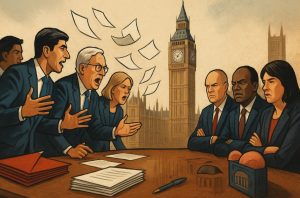Table of Contents
ToggleWhat Did Angela Rayner Propose in the Leaked Memo?
In a political revelation that has reignited the debate on Labour’s fiscal intentions, Deputy Prime Minister Angela Rayner was reportedly behind a controversial memo suggesting a series of tax increases aimed squarely at savers and wealthy investors.
The memo, titled “Alternative Proposals for Raising Revenue”, was submitted to Chancellor Rachel Reeves in the weeks leading up to the 2025 Spring Statement.
According to leaked documents obtained by The Telegraph, Rayner proposed measures that could generate between £3 billion and £4 billion annually. The intention was to avoid the £5 billion in welfare cuts that Reeves later announced.
While the Chancellor chose not to implement the proposals, their mere suggestion has triggered backlash from across the political spectrum and exposed ideological divisions within Labour’s leadership.
This internal communication reflects a broader conversation within Labour about how to balance fiscal responsibility with social equity. The memo did not constitute formal policy, but it has highlighted the potential trajectory of future tax reforms under a Labour government.
Why Did Rayner Suggest Reinstating the Pensions Lifetime Allowance?

One of the most significant and contentious proposals in Rayner’s memo was the reinstatement of the pensions lifetime allowance (LTA).
This allowance, abolished by the Conservatives in 2023, previously capped the amount individuals could save into their pension pots tax-free. Surpassing the limit triggered a punitive tax rate of up to 55% on the excess savings.
The rationale behind bringing the LTA back is rooted in two key arguments. Firstly, it would restore what some within Labour view as a necessary check against excessive tax-free pension accumulation by the wealthiest individuals.
Secondly, it is a lucrative revenue stream; reintroducing the LTA could generate close to £1 billion annually, according to Treasury estimates.
The political symbolism is also notable. The Conservative-led abolition was seen by critics as favouring high-income earners.
By reversing that move, Labour would be aligning policy with its manifesto commitment to fairer taxation and wealth redistribution, though the reversal of this very idea during the last general election complicates its re-emergence.
Could Dividend Taxes Be Increased Under Labour?
Dividend income has long enjoyed favourable tax treatment compared to regular employment earnings. Angela Rayner’s memo targeted this disparity by recommending two key changes: the complete removal of the tax-free dividend allowance and the alignment of dividend tax rates with income tax bands.
Under current rules, investors receive a £1,000 tax-free dividend allowance, with rates thereafter ranging from 8.75% to 39.35%, depending on the taxpayer’s income bracket.
Rayner’s proposal would eliminate the allowance and potentially raise dividend tax rates to match income tax rates, meaning rates could climb to up to 45% for top earners.
These changes, if enacted, would have sweeping consequences. Small business owners who pay themselves through dividends, as well as individual investors who rely on them for passive income, could see a sharp increase in tax liabilities.
Advocates argue such a move ensures income equality across different sources, while critics warn it could disincentivise investment and entrepreneurship.
What Other Tax Measures Were Recommended in Rayner’s Memo?

Beyond pensions and dividends, Rayner’s memo outlined several other tax increases aimed at generating revenue without touching the earnings of lower-income households.
The memo framed these proposals as “popular, prudent, and progressive,” in line with Labour’s pledge not to raise taxes on working people.
Among the most notable suggestions:
- Ending inheritance tax relief on shares in the Alternative Investment Market (AIM), which currently allows these shares to be passed on without inheritance tax. Removing this relief could raise up to £1 billion per year.
- Freezing the additional rate income tax threshold at £125,140, effectively dragging more people into the 45% tax bracket as wages rise with inflation.
- Increasing the bank corporation tax surcharge from 3% to 5%, aiming to make banks contribute more to the exchequer.
- Closing stamp duty loopholes in commercial property transactions to prevent tax avoidance in high-value deals.
- Raising the annual tax on enveloped dwellings (ATED) properties held through corporate entities is a measure aimed at curbing tax avoidance through opaque ownership structures.
Each measure reflects a strategy to close perceived loopholes in the current system and ensure that wealth, rather than work, bears a greater share of the tax burden.
How Has Rachel Reeves Responded to These Proposals?
Chancellor Rachel Reeves has consistently positioned herself as a fiscally responsible steward of the economy, drawing a clear line against widespread tax increases.
Her response to Rayner’s memo was measured: she did not act on any of the suggested reforms and instead proceeded with £5 billion in welfare cuts during the Spring Statement.
Insiders suggest this divergence points to deeper ideological divides within the Cabinet. While Reeves is focused on maintaining market confidence and keeping borrowing in check, Rayner and others on Labour’s left flank believe the government should prioritise taxing wealth over reducing welfare.
The Chancellor has also maintained that day-to-day spending must be funded from current revenue, not borrowing a position that limits her willingness to make expansive fiscal commitments without new sources of income.
What Is the Impact on UK Savers and Investors?

Should any of Rayner’s proposals gain traction in future budgets, UK savers and investors stand to be significantly affected. Those who rely on dividends, hold AIM shares, or are building up pension wealth may face new taxes and limits on their financial strategies.
The changes could alter how people approach long-term planning. The use of ISAs, pensions, and investment portfolios may need to be re-evaluated depending on the eventual direction Labour’s policy takes. For now, the memo remains unofficial, but the ideas within it are far from dormant.
Why Is There Growing Tension Within the Labour Party?
The leaked memo has laid bare the ideological rift within Labour’s leadership. Rayner and several MPs are pushing for a more traditional, redistributive Labour platform, arguing that taxing the wealthy is more equitable than cutting benefits.
On the other hand, Reeves is focused on proving Labour’s economic credibility, especially in the eyes of the financial markets.
Public opposition from MPs such as Neil Duncan-Jordan, who criticised welfare reforms as likely to push 400,000 people into poverty, has intensified internal scrutiny.
Moreover, decisions like removing winter fuel payments for all but the poorest pensioners have stirred discontent among backbenchers, many of whom attribute local election setbacks to such unpopular cuts.
These tensions suggest that Labour’s policy direction on taxation and public spending is still being contested behind the scenes.
How Are the Conservatives Responding to the Memo?

Unsurprisingly, the Conservative Party has seized the opportunity to attack Labour’s internal discord and tax ambitions. Shadow Chancellor Mel Stride warned that the memo confirms Labour is preparing for another round of tax increases, likening the current leadership to the Corbyn-era left.
Neil O’Brien, Shadow Education Minister, called the proposals “very alarming” and accused Labour of punishing working families already struggling under a heavy tax burden. He further argued that additional taxation would stifle growth, harm business confidence, and exacerbate economic stagnation.
These attacks are likely to form a central theme in the Conservatives’ campaign messaging as the general election nears.
Table: Summary of Proposed Measures in Rayner’s Memo
| Policy Proposal | Description | Estimated Revenue |
| Reinstate Pensions Lifetime Allowance | Cap tax-free pension savings | £800m–£1bn |
| Scrap Dividend Allowance | Eliminate the £1,000 tax-free threshold for dividends | £1bn–£1.5bn |
| Align Dividend Tax with Income Tax | Raise dividend tax rates up to 45% for top earners | £500m–£700m |
| End AIM Inheritance Tax Relief | Tax inheritance of shares on the Alternative Investment Market | £1bn |
| Increase Bank Corporation Tax Surcharge | Raise surcharge from 3% to 5% | £500m |
| Freeze Additional Rate Tax Threshold | Keep 45% tax threshold at £125,140 despite inflation | £300m |
| Close Commercial Property Stamp Duty Loopholes | Tackle avoidance in large-scale property deals | £200m–£400m |
| Raise ATED on Enveloped Dwellings | Higher taxes on properties held through offshore or corporate vehicles | £150m |
Conclusion: Is Labour Heading for a Tax Showdown on Savers?
The leak of Angela Rayner’s memo has added fresh fuel to long-standing debates over how Labour intends to govern. While not official policy, the proposals underscore the tug-of-war within Labour between fiscal pragmatism and ideological redistribution.
For savers, pensioners, and investors, the key takeaway is that change may be on the horizon, even if it is not immediate. The debate over whether wealth should bear more of the tax burden will likely define the next phase of Labour’s economic narrative.
Whether Reeves ultimately endorses any of Rayner’s proposals may depend on the state of public finances and the political calculus following the next general election.
Frequently Asked Questions
Will the pensions lifetime allowance return?
It has not been reinstated yet, but Angela Rayner has proposed it. Any return would require formal policy adoption by the Treasury.
Are dividend taxes going to rise?
Not at this time. However, proposals exist to raise them significantly. Investors should monitor budget announcements closely.
Is this memo now Labour policy?
No, it was an internal document and not approved by ministers. However, it reflects real discussions within the party.
Could ISAs be affected?
The memo did not mention ISAs directly, but changes to investment-related tax allowances could still impact how people save.
Why is there opposition within Labour?
Some MPs and ministers disagree over whether to raise taxes or cut spending. The leaked memo highlights these divisions.
How have the Conservatives reacted?
They’ve criticised the proposals as harmful and “alarming”, claiming they reflect a return to outdated tax-and-spend policies.
What can savers do to prepare?
Stay informed, review portfolios, and consult financial advisers to ensure investments remain tax-efficient in a changing landscape.




